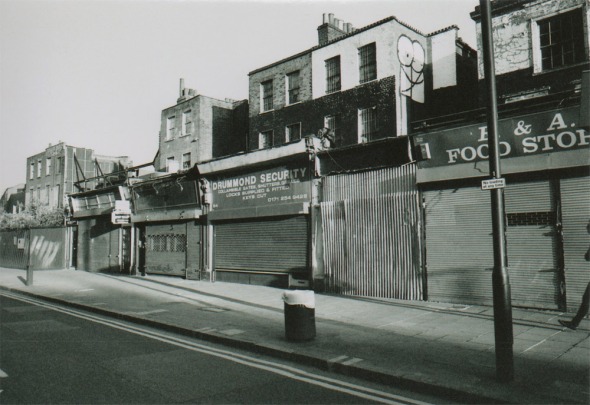Ten imperatives.
Posted: February 24, 2014 Filed under: Architectural, Crime and Punishment, Events, Graffiti, Lettering, Public Announcements, Shops | Tags: abney park cemetery, Banksy, miners' strike, Old Vic, Peter Sutcliffe trial Comments Off on Ten imperatives. Borough. © David Secombe 2010.
Borough. © David Secombe 2010.
 Camden Lock. © David Secombe 1985.
Camden Lock. © David Secombe 1985.
 Protestor outside the Old Bailey on the final day of the Peter Sutcliffe trial. © David Secombe 1981.
Protestor outside the Old Bailey on the final day of the Peter Sutcliffe trial. © David Secombe 1981.
 Banksy stencil, Borough Market. © David Secombe 2003.
Banksy stencil, Borough Market. © David Secombe 2003.
 Props outside the stage door, Old Vic. © David Secombe 1988.
Props outside the stage door, Old Vic. © David Secombe 1988.
 Pet shop, Brockley. © David Secombe 2003.
Pet shop, Brockley. © David Secombe 2003.
 Abandoned pub, Bermondsey. © David Secombe, 2010.
Abandoned pub, Bermondsey. © David Secombe, 2010.
 Pub toilet, Waterloo. © David Secombe 2008.
Pub toilet, Waterloo. © David Secombe 2008.
 Sign outside a cafe, Brockley. © David Secombe 2010.
Sign outside a cafe, Brockley. © David Secombe 2010.
 Abney Park Cemetery, N16. © David Secombe 2010.
Abney Park Cemetery, N16. © David Secombe 2010.
The Death of Dalston Lane.
Posted: February 13, 2014 Filed under: Architectural, Catastrophes, Conspiracies, Dereliction, Housing, Vanishings | Tags: Bill Parry-Davies, Dalston Lane, Death of London, hackney council, Iain Hamilton, Open Dalston Comments Off on The Death of Dalston Lane. Dalston Lane, May 2010. © David Secombe.
Dalston Lane, May 2010. © David Secombe.
From Open Dalston, 20 December & 11 February 2014:
Hackney to demolish sixteen Georgian houses in Dalston Lane
 Dalston Lane, May 2010. © David Secombe.
Dalston Lane, May 2010. © David Secombe.
From Hackney, That Rose-Red Empire* by Iain Sinclair:
Dalston Lane
Once a street is noticed it’s doomed. Endgame squatters, slogans. DALSTON! WHO ASKED U? PROTECTED BY OCCUPATION. Torched terraces. Overlapping, many-coloured tags. Aerosol signatures on silver roll-down shutters. Scrofulous rubble held up by flyers for weekend noise events. THIS WORLD IS RULED BY THOSE WHO LIE. They said, the ones who make it their business to investigate such things, that there was a direct relationship between properties that applied for conservation status and arson attacks, petrol bombs. Unexplained fires. Moscow methods arrived in town with the first sniff of post-Soviet money. Russian clubs were opening in the unlikeliest places. We no longer had much to offer in the way of oil and utilities, energy resources, but we had heritage to asset-strip: Georgian wrecks proud of their status.
* Hamish Hamilton, 2009.
 Dalston Lane, May 2010. © David Secombe.
Dalston Lane, May 2010. © David Secombe.
D.S.: The shameful saga of Dalston Lane is a microcosm of the fate of the East End as a whole: a sorry mash-up of corporate and council greed flying under the discredited banner of ‘regeneration’. The cynical, Blairite language of contemporary urban development expressed by developers and local authorities deserves a study in itself: ‘affordable housing’ (i.e. ‘unaffordable affordable housing’); councils ‘competing’ with other boroughs for resources (food? water? air?); ‘conservation-led schemes’ (wherein conservation is a synonym for demolition – along the lines of, ‘We had to demolish the terrace in order to conserve it.’). It is language that might have been invented by Orwell. The fact that a Labour council is responsible for such wanton cynicism towards its own residents is deeply depressing and makes one despair for the fate of the city. The death of Dalston Lane is the death of London.
For further reading on this long-festering matter, see Bill Parry-Davies’ site Open Dalston.


